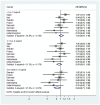Tea consumption and incidence of type 2 diabetes in Europe: the EPIC-InterAct case-cohort study
- PMID: 22666334
- PMCID: PMC3364250
- DOI: 10.1371/journal.pone.0036910
Tea consumption and incidence of type 2 diabetes in Europe: the EPIC-InterAct case-cohort study
Abstract
Background: In previous meta-analyses, tea consumption has been associated with lower incidence of type 2 diabetes. It is unclear, however, if tea is associated inversely over the entire range of intake. Therefore, we investigated the association between tea consumption and incidence of type 2 diabetes in a European population.
Methodology/principal findings: The EPIC-InterAct case-cohort study was conducted in 26 centers in 8 European countries and consists of a total of 12,403 incident type 2 diabetes cases and a stratified subcohort of 16,835 individuals from a total cohort of 340,234 participants with 3.99 million person-years of follow-up. Country-specific Hazard Ratios (HR) for incidence of type 2 diabetes were obtained after adjustment for lifestyle and dietary factors using a Cox regression adapted for a case-cohort design. Subsequently, country-specific HR were combined using a random effects meta-analysis. Tea consumption was studied as categorical variable (0, >0-<1, 1-<4, ≥ 4 cups/day). The dose-response of the association was further explored by restricted cubic spline regression. Country specific medians of tea consumption ranged from 0 cups/day in Spain to 4 cups/day in United Kingdom. Tea consumption was associated inversely with incidence of type 2 diabetes; the HR was 0.84 [95%CI 0.71, 1.00] when participants who drank ≥ 4 cups of tea per day were compared with non-drinkers (p(linear trend) = 0.04). Incidence of type 2 diabetes already tended to be lower with tea consumption of 1-<4 cups/day (HR = 0.93 [95%CI 0.81, 1.05]). Spline regression did not suggest a non-linear association (p(non-linearity) = 0.20).
Conclusions/significance: A linear inverse association was observed between tea consumption and incidence of type 2 diabetes. People who drink at least 4 cups of tea per day may have a 16% lower risk of developing type 2 diabetes than non-tea drinkers.
Conflict of interest statement
Figures



References
-
- Wild S, Roglic G, Green A, Sicree R, King H. Global prevalence of diabetes: estimates for the year 2000 and projections for 2030. Diabetes Care. 2004;27(5):1047–1053. - PubMed
-
- Abdullah A, Peeters A, de Courten M, Stoelwinder J. The magnitude of association between overweight and obesity and the risk of diabetes: a meta-analysis of prospective cohort studies. Diabetes Res Clin Pract. 2010;89(3):309–319. - PubMed
-
- Manikandan R, Sundaram R, Thiagarajan R, Sivakumar MR, Meiyalagan V, et al. Effect of black tea on histological and immunohistochemical changes in pancreatic tissues of normal and streptozotocin-induced diabetic mice (Mus musculus). Microsc Res Tech. 2009;72(10):723–726. - PubMed
-
- Lenzen S. Oxidative stress: the vulnerable beta-cell. Biochem Soc Trans 36(Pt. 2008;3):343–347. - PubMed
-
- Kao YH, Chang HH, Lee MJ, Chen CL. Tea, obesity, and diabetes. Mol Nutr Food Res. 2006;50(2):188–210. - PubMed

